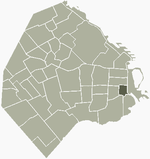San Telmo
| San Telmo | ||
|---|---|---|
| Barrio | ||

Clockwise from top: the Russian Orthodox Cathedral of the Holy Trinity, Lezama Park, a Tango show in Dorrego Square and antique fairs in Defensa Street.
|
||
|
||
 Location of San Telmo within Buenos Aires |
||
| Country |
|
|
| Autonomous City | Buenos Aires | |
| Comuna | C1 | |
| Important sites |
Plaza Dorrego National Museum of History |
|
| Area | ||
| • Total | 1.3 km2 (0.5 sq mi) | |
| Population (2001) | ||
| • Total | 25,969 | |
| • Density | 20,000/km2 (52,000/sq mi) | |
| Time zone | ART (UTC-3) | |
San Telmo ("Saint Pedro González Telmo") is the oldest barrio (neighborhood) of Buenos Aires, Argentina. It is a well-preserved area of the Argentine metropolis and is characterized by its colonial buildings. Cafes, tango parlors and antique shops line the cobblestone streets, which are often filled with artists and dancers. A street named the "Illuminated Block" is where many of these important historical buildings can be found.
San Telmo's attractions include old churches (e.g. San Pedro Telmo), museums, antique stores and a semi-permanent antique fair (Feria de Antigüedades) in the main public square, Plaza Dorrego. Tango-related activities for both locals and tourists are in the area.
Known as San Pedro Heights during the 17th century, the area was mostly home to the city's growing contingent of dockworkers and brickmakers; indeed, the area became Buenos Aires' first "industrial" area, home to its first windmill and most of the early city's brick kilns and warehouses. The bulk of the city's exports of wool, hides and leather (the Argentine region's chief source of income as late as the 1870s) were prepared and stored here in colonial times. Their presence led to the first residential settlements in this area: that of Africans, slaves and free, alike.
Previously separated from Buenos Aires proper by a ravine, the area was formally incorporated into the city in 1708 as the "Ovens and Storehouses of San Pedro." The neighborhood's poverty led the Jesuits to found a "Spiritual House" in the area, a charitable and educational mission referred to by San Pedro's indigent as "the Residence;" their 1767 suppression led to the mission's closure, however.
The void left by the Jesuits' departure was addressed by the 1806 establishment of the Parish of San Pedro González Telmo (or "San Telmo"), so named in honor of the Patron Saint of seafarers. This move failed to replace the lost social institutions, however, and San Telmo languished well after Argentine independence in 1816. The Jesuit Residence, restored as a clinic by Guatemalan friars, was shuttered in 1821, and San Telmo saw no public works for the next 30 years except a Black Infantrymen's Quarters and the construction of the dreaded Mazorca Dungeon by Governor Juan Manuel de Rosas.
...
Wikipedia

